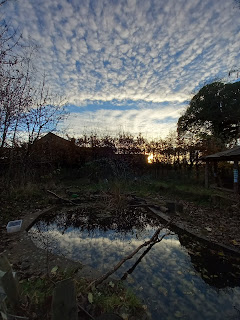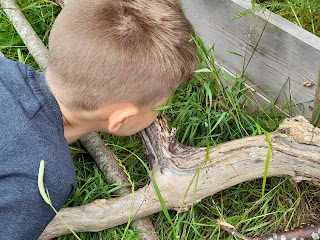Adapting Forest School
When you are a member of different online Forest School groups you realise the diversity of practice there is to choose from.
The differences depend on many things. Some Forest School's provide all day sessions, some all day every day, and need to track what they do as they have a wide curriculum to cover, and if they are providing education in lieu of a state school. Some Forest Schools are independent businesses offering a 2 hour session as child care, or as an educational add on, or as a leisure activity. Some, like ours, are set within a school and are part of the curriculum their school provides.
Forest School can therefore be enjoyed on school grounds, or private land, or rented sites. They may be specifically for this use, may share some or all of their space, or may to open to the public.
None should be judged as better or worse. If you are a parent looking to find a Forest School for your child then it means there is a range out there that you can explore - although what is available in your area may restrict your choices.
Then there is the Forest School Leader. Training IS standard in many ways, but just as doing a degree at a Uni offers different routes to the same exam, different training providers have different approaches or emphasis when helping FSL put together portfolios and essays. Like any teacher or practitioner you can't help but bring your own likes and dislikes to the role, your strengths and your hobbies may influence the kinds of activities you offer the children. If you are very creative then there may be many craft activities, it you love woodwork there may be lots of birdboxes and forest furniture produced, if you love cooking the campfire may be more of a kitchen! No one way is right, there are benefits and compromises in all cases.
Staffing and 'class' size will also have an impact. Ratios should always be met for safety reasons, but a full time Forest School will have people trained to continue supervising the session while the Forest School Leader is involved in an activity. This means that the remaining children have access to staff who can answer their questions or engage in a different Forest School activity.
This is where numbers influence Forest School. If the session has ten children and
2 are engaging in woodwork with the FSL then the remaining 6 exploring elsewhere may enjoy more support than if there were a further 28.Age groups also influence some activities, as does knowing your children. Pupils I have worked with for a few years, who I know understand safety rules, may have greater freedom. In my last setting I could work with a year 2 group using penknives while 2 children independently used a bow saw nearby because that group had completed Forest School sessions with me in Nursery, and Reception, AND Year 1. I although I needed to watch to ensure there wasn't an accident, I didn't need to supervise behaviour or technique. I was therefore able to work with 6 children in the tool area, moving between the pairs, while another FSL (who wasn't leading the session) supervised and supported the rest of the class of 30.
Quality Forest School depends on some very flexible ideals:
- Quality Forest School is long enough
- Quality Forest School is risky enough/safe enough
- Quality Forest School promotes holistic development
- Quality Forest School is natural enough
- Quality Forest School has learner led outcomes
- Quality Forest School is run by qualified and reflective leaders
So everything I have said about varied provision is true, as long as it meets these criteria it is 'proper' Forest School provision, but it will do so in a variety of ways.
The pressure for these criteria to be 'relaxed' or outright ignored frequently comes from schools. Within the circle of Forest School Leaders I communicate with many are under pressure to 'compromise' - meaning abandoning at least one of the six criteria. Session times are cut to fit into a school day. Specific learning intentions are assigned taking away the the learner led outcomes, or worse still specific activities with specified products expected. In one case non-qualified FSL were allowed to provide sessions...
For many it is very frustrating.
2020 is an anomaly in most of our lives. The disruption to the norm ebbs and flows into every area family, work, business, and life in general. The decision to 'compromise' for many may be reluctant but is now a case of adaptation in order to provide sessions at all.
Activities and sites have to be reviewed and sometimes altered. Timings, ratios, and numbers participating have to be juggled. The financial viability of some Forest School Businesses is in the balance. Access to sites has at times been restricted. Right now 'Quality' hasn't been abandoned or compromised, it's been reviewed to ensure they children have SOME access to quality outdoor learning.
In school's there is also change. The benefits of Forest School have never been needed as much as post Lockdown 1, mid pandemic, and now into lockdown 2! But offering these opportunities to as many children as possible also means adaptation.
Our Forest School isn't actually doing Forest School! It is NOT long enough sessions rarely exceed an hour and never last the full 2 hours that qualify it as a Forest School session. So this exempts us for claiming QUALITY!
However the shortened sessions ARE run by a qualified and reflective leader, there is plenty of risk, self assessment, and choice available. Sessions do promote holistic development, are immersed in nature, and follows the lead of the children with learner led outcomes. Our adaptation is purely to allow ALL of our pupils weekly access to a 'Forest School' session - 'Forest School Lite'!
This version of Sessions wouldn't have been required ten years ago - or even one year
ago. Children have always needed time outside, in nature, building resilience and following their own learning, but being out in fresh air currently offers a much safer environment: The break from the four walls of home and classroom allows freedom that lockdown restricts, the break in concentration and engaging in physical movement allows a 'brain break', and the open space, breeze, and lack of ceiling allows the corona virus space to avoid humans! It's a format we started way back in June and have seen through to date.
Ultimately Outdoor Learning is essential.
There are some hidden bonuses in this format too. With the entire school involved in 'Forest School Lite' staff get first hand experience of what the benefits are. They get to see how their pupils change in this environment, they get to engage with them in a different way, and they get to listen to the knowledge the children bring to the session. Hopefully it helps their confidence with taking learning outside and planning their own Outdoor Learning lessons, and it is a chance to escape the classroom and enjoy the space. The current restrictions because of covid take a toll on everyone's thought process and well being, time outside feels safer and less stressful than many classrooms.
Will all Forest Schools be able to find ways of staying open and viable as businesses at a time when they are needed most?
Will school's be able to revert to a latter day timetable (circa 2019) that makes space for full Forest School Sessions?
Only time will tell.
Meanwhile, Mama Beech watches over almost 400 children a week. Feels them climb her branches and swing from the ropes she supports. She offers shelter from the showers and shade from the low Autumn sun. She looks down on a Copse that is expanding with a maze of hedges being planted by the children, and a basecamp that offers a selection of equipment and activities the children can choose or ignore.
From 4 year olds to 11 year olds, an entire school of pupils get to explore and discover, investigate and participate, and most importantly enjoy.











Comments
Post a Comment